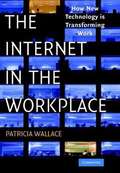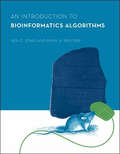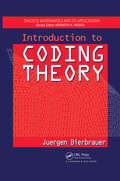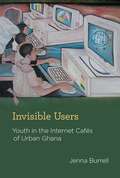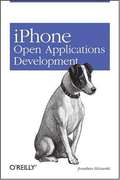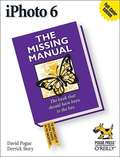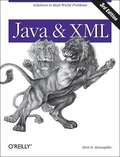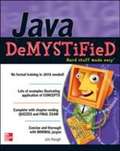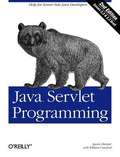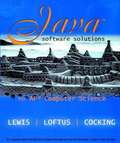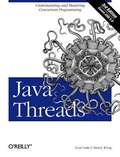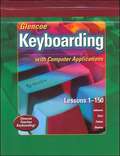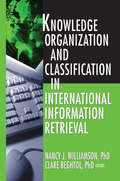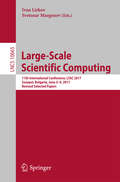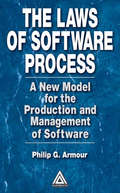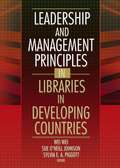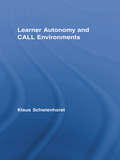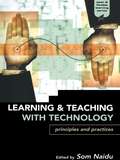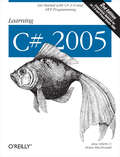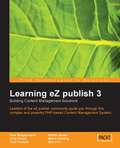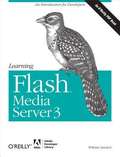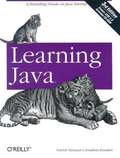- Table View
- List View
The Internet in the Workplace: How New Technology is Transforming Work
by Patricia Wallace"[P]rovides fascinating insights into how we view our role in society and our work. This book is worth a read." An expansive overview of online behavior--from deception and aggression to altruism and romance--as well as of the elements that make the Internet 'addictive.' This is a well-organized and accessible primer on the impact of the Internet on social and workplace dynamics." Good introduction to the myriad new issues and reconfigured challenges arising from this new technology with respect to telecommuting, e-commerce, electronic communications, personal boundaries, career paths, leadership paradigms, customer relationships, employee rights, security of information and knowledge, continuing education, and preparation for more coming changes
An Introduction to Bioinformatics Algorithms (Computational Molecular Biology)
by Neil C. Jones Pavel A. PevznerAn introductory text that emphasizes the underlying algorithmic ideas that are driving advances in bioinformatics.This introductory text offers a clear exposition of the algorithmic principles driving advances in bioinformatics. Accessible to students in both biology and computer science, it strikes a unique balance between rigorous mathematics and practical techniques, emphasizing the ideas underlying algorithms rather than offering a collection of apparently unrelated problems. The book introduces biological and algorithmic ideas together, linking issues in computer science to biology and thus capturing the interest of students in both subjects. It demonstrates that relatively few design techniques can be used to solve a large number of practical problems in biology, and presents this material intuitively. An Introduction to Bioinformatics Algorithms is one of the first books on bioinformatics that can be used by students at an undergraduate level. It includes a dual table of contents, organized by algorithmic idea and biological idea; discussions of biologically relevant problems, including a detailed problem formulation and one or more solutions for each; and brief biographical sketches of leading figures in the field. These interesting vignettes offer students a glimpse of the inspirations and motivations for real work in bioinformatics, making the concepts presented in the text more concrete and the techniques more approachable.PowerPoint presentations, practical bioinformatics problems, sample code, diagrams, demonstrations, and other materials can be found at the Author's website.
Introduction to Coding Theory (Discrete Mathematics and Its Applications #5)
by Jurgen BierbrauerAlthough its roots lie in information theory, the applications of coding theory now extend to statistics, cryptography, and many areas of pure mathematics, as well as pervading large parts of theoretical computer science, from universal hashing to numerical integration.Introduction to Coding Theory introduces the theory of error-correcting codes in a thorough but gentle presentation. Part I begins with basic concepts, then builds from binary linear codes and Reed-Solomon codes to universal hashing, asymptotic results, and 3-dimensional codes. Part II emphasizes cyclic codes, applications, and the geometric desciption of codes. The author takes a unique, more natural approach to cyclic codes that is not couched in ring theory but by virtue of its simplicity, leads to far-reaching generalizations. Throughout the book, his discussions are packed with applications that include, but reach well beyond, data transmission, with each one introduced as soon as the codes are developed.Although designed as an undergraduate text with myriad exercises, lists of key topics, and chapter summaries, Introduction to Coding Theory explores enough advanced topics to hold equal value as a graduate text and professional reference. Mastering the contents of this book brings a complete understanding of the theory of cyclic codes, including their various applications and the Euclidean algorithm decoding of BCH-codes, and carries readers to the level of the most recent research.
Invisible Users
by Jenna BurrellThe urban youth frequenting the Internet cafes of Accra, Ghana, who are decidedly not members of their country's elite, use the Internet largely as a way to orchestrate encounters across distance and amass foreign ties--activities once limited to the wealthy, university-educated classes. The Internet, accessed on second-hand computers (castoffs from the United States and Europe), has become for these youths a means of enacting a more cosmopolitan self. In Invisible Users, Jenna Burrell offers a richly observed account of how these Internet enthusiasts have adopted, and adapted to their own priorities, a technological system that was not designed with them in mind. Burrell describes the material space of the urban Internet cafe and the virtual space of push and pull between young Ghanaians and the foreigners they encounter online; the region's famous 419 scam strategies and the rumors of "big gains" that fuel them; the influential role of churches and theories about how the supernatural operates through the network; and development rhetoric about digital technologies and the future viability of African Internet cafes in the region. Burrell, integrating concepts from science and technology studies and African studies with empirical findings from her own field work in Ghana, captures the interpretive flexibility of technology by users in the margins but also highlights how their invisibility puts limits on their full inclusion into a global network society.
iPhone Open Application Development
by Jonathan A. ZdziarskiCertain technologies bring out everyone's hidden geek, and iPhone did the moment it was released. Even though Apple created iPhone as a closed device, tens of thousands of developers bought them with the express purpose of designing and running third-party software. In this clear and concise book, veteran hacker Jonathan Zdziarski -- one of the original hackers of the iPhone -- explains the iPhone's native environment and how you can build software for this device using its Objective-C, C, and C++ development frameworks. iPhone Open Application Development walks you through the iPhone's native development environment, offers an overview of the Objective-C language you'll use with it, and supplies background for the iPhone operating system. You also get detailed recipes and working examples for everyone's favorite iPhone features -- graphics and audio programming, interfaces for adding multitouch functionality to games, the use of hardware sensors, and the device's vast user interface kit. This book explains: How to access the iPhone's underlying operating system The makeup of an iPhone application How to get the open source tool chain running on your desktop The iPhone's core user interface framework, which is heavily tied to major application-level functions Using the many touted iPhone features such as multitouch, hardware sensors, and gestures Intercepting and handling event notifications for many iPhone-related events Raw video surfaces and 3D transformations that take you deeper into advanced graphics on the iPhone How to record and play simple sounds and intercept sound events Advanced digital audio output using Apple's new Audio Toolbox framework Advanced user interface components such as section lists, keyboards, and image manipulation The Appendix includes a compendium of miscellaneous code examples for cool application features, such as using the camera and creating a CoverFlow®-like album browser. This book is a true hacker's book, designed for the millions of users who have run third party applications on their iPhone, but its concepts and code examples have shown to be remarkably similar to Apple's official SDK, making this book a valuable resource for both camps. Any programmer can use this book to write applications with the same spectacular effects that made the device an immediate hit, and impress users just as much as the official iPhone software does. That programmer can easily be you.
iPhoto 6: The Missing Manual
by David Pogue Derrick StoryIf you used iPhoto when it first came out, you'll remember the way it slowed to a crawl once you loaded it with about 2,000 photos. Compare that to this year's model: iPhoto 6 can handle as many as 250,000 images and still have the power to run a host of suped-up features. Its new software engine lets you make changes with a drag and drop editing tool, find photos with a robust search feature, and manipulate images without affecting the originals in your master library. You can also: View and work on full-screen images Make quick edits with one click Work with RAW images Create cool new calendars, greeting cards and books Post photos online with the new iWeb application Use a method of sharing called "Photocasting" Apple makes it all sound so easy: just drag this, click that and you're done. But, as intuitive as these features are, you can still get lost, especially if you're new to iPhoto. Not to worry. iPhoto 6: The Missing Manual gives you plenty of undocumented tips and tricks for taking advantage of the new version and every little feature packed into it. It's the top-selling iPhoto book for good reason. With wit and objectivity, David Pogue and Derrick Story start you out with a crash course on digital photography, complete with tutorials on buying a camera, composing brilliant photos in various situations (sports, portraits, nighttime shots, even kid photography), and making digital movies. From there, you'll dive into every detail of iPhoto, from camera-meets-Mac basics to storing, searching, editing, and creating books, calendars and greeting cards. You'll learn to build a personal web site built with iWeb, and discover "Photocasting"--the new service that allows. Mac subscribers to publish photo albums online so that others can use the photos, even if they work on PCs. With iPhoto 6, you could add 1000 photos a month for the next 20 years and not fill it. With iPhoto 6: The Missing Manual, you can get going in no time.
IRC Hacks
by Paul MuttonIRC (Internet Relay Chat) may very well turn out to be the world's most successful hack. In 1988, Jarkko Oikarinen wrote the original IRC program at the University of Oulu, Finland. As he says in his foreword, "IRC started as one summer trainee's programming exercise. A hack grew into a software development project that hundreds of people participated in, and then became a worldwide environment where tens of thousands of people now spend time with each other. I have found many of my friends through IRC and learnt a significant part of my present software engineering knowledge while using and working with IRC. That would not have been possible without learning from code examples and hacks from others". IRC has continued to grow in popularity since its inception. Millions of people from all over the world now use IRC to chat with friends, discuss projects and collaborate on research. With a simple, clearly defined protocol, IRC has become one of the most accessible chat environments, with clients written for a multitude of operating systems. And IRC is more than just a simple chat system it is a network of intercommunicating servers, allowing thousands of clients to connect from anywhere in the world using the IRC protocol. While IRC is easy to get into and many people are happy to use it without being aware of what's happening under the hood, there are those who hunger for more knowledge, and this book is for them. IRC Hacks is a collection of tips and tools that cover just about everything needed to become a true IRC master, featuring contributions from some of the most renowned IRC hackers, many of whom collaborated on IRC, grouping together to form the channel #irchacks on the freenode IRC network (irc.freenode.net). Like all of our Hacks books, there are many different ways to use IRC Hacks. You can read the book from cover to cover, but you might be better served by picking an interesting item from the table of contents and just diving in. If you're relatively new to IRC, you should considering starting with a few hacks from each progressive chapter. Chapter 1 starts you off by showing you how to connect to IRC, while Chapter 2 acquaints you with the everyday concepts you'll need to use IRC effectively. Chapter 3 is all about users and channels, and introduces the first pieces of code. Chapter 4 shows you how to make useful enhancements to IRC clients. Chapter 5 is where you will learn the basics about creating IRC bots, with Chapters 6-12 introducing more complex bots that can be used for logging, servicing communities, searching, announcing, networking, managing channels or simply for having fun. Chapter 13 delves into the IRC protocol in more detail, and Chapter 14 demonstrates some interesting alternative methods for connecting to IRC. Finally, Chapter 15 will move you on to new pastures by showing you how to set up your own IRC server. This book presents an opportunity to learn how IRC works and how to make best use of some of the features that have made it the most successful, most scalable, and most mature chat system on this planet. IRC Hacks delves deep into the possibilities.
Java and XML
by Brett MclaughlinThorough knowledge of both Java and XML is indispensable if developers want to build modern web applications. Because both languages are platform independent, they are ubiquitous in the world of web development, and the combination of the two allows enterprises to lower the costs of information sharing for e-commerce and other high-octane web applications and services. Our third edition of Java and XML is ideal for any Java developer who wants to take advantage of XML without having to become an expert on the markup language. So, unlike other XML titles, this book is written from a Java developer's point of view, and assumes no prior knowledge of XML. The new edition has been thoroughly revised with coverage of Java 5.0 as well as new standards for SOAP, a key web services technology that works with XML and provides a central part of Microsoft's .NET platform.
Java Demystified
by Jim Keogh Wendy RinaldiLearn Java with this fun and painless self-teaching guide. Easy-to-understand, step-by-step instruction explains the most commonly used programming language for designing dynamic Web pages. Numerous examples, quizzes at the end of each chapter, and a final exam solidify the knowledge you have learned.
Java Servlet Programming, 2nd Edition
by Jason HunterThe second edition of this popular book has been completely updated to add the new features of the Java Servlet API Version 2.2, and new chapters on servlet security and advanced communication. In addition to complete coverage of the 2.2 specification, we have included bonus material on the new 2.3 version of the specification.
Java Software Solutions for AP Computer Science: Foundations for Program Design
by John Lewis William Loftus Cara CockingSpecifically designed for beginning programmers, this Advanced Placement book matches the AP Computer Science topic outline and Java subset set forth by the College Board.
Java Threads, Third Edition
by Scott Oaks Henry WongThreads are essential to Java programming, but learning to use them effectively is a nontrivial task. This new edition of the classic Java Threads shows you how to take full advantage of Java's threading facilities and brings you up-to-date with the watershed changes in Java 2 Standard Edition version 5.0 (J2SE 5.0). It provides a thorough, step-by-step approach to threads programming.
Kernel Methods for Pattern Analysis
by John Shawe-Taylor Nello CristianiniKernel methods provide a powerful and unified framework for pattern discovery, motivating algorithms that can act on general types of data (e. g. strings, vectors or text) and look for general types of relations (e. g. rankings, classifications, regressions, clusters). The application areas range from neural networks and pattern recognition to machine learning and data mining. This book, developed from lectures and tutorials, fulfils two major roles: firstly it provides practitioners with a large toolkit of algorithms, kernels and solutions ready to use for standard pattern discovery problems in fields such as bioinformatics, text analysis, image analysis. Secondly it provides an easy introduction for students and researchers to the growing field of kernel-based pattern analysis, demonstrating with examples how to handcraft an algorithm or a kernel for a new specific application, and covering all the necessary conceptual and mathematical tools to do so.
Keyboarding with Computer Applications
by Jack E. Johnson Judith Chiri-Mulkey Delores Sykes Cotton Carole G. StanleyKeyboarding, Word Processing, Spreadsheets, Desktop Publishing, Databases.
Knowledge Organization and Classification in International Information Retrieval
by Nancy Williamson Clare BeghtolLearn step-by-step how to develop knowledge-based products for international use! Knowledge Organization and Classification in International Information Retrieval examines current efforts to deal with the increasing globalization of information and knowledge. International authors walk you through the theoretical foundations and conceptual elements behind knowledge management, addressing areas such as the Internet, multinational resources, translations, and information languages. The tools, techniques, and case studies provided in this book will be invaluable to anyone interested in bridging the international information retrieval language gap. This book is divided into four sections that address major themes for internationalized information and knowledge: "General Bibliographic Systems" discusses how bibliographic classification systems can be adapted for specific subjects, the problems with addressing different language expressions, and the future of these systems "Information Organization in Knowledge Resources" explores knowledge organization and classification, focusing mainly on libraries and on the Internet "Linguistics, Terminology, and Natural Language Processing" analyzes the latest developments in language processing and the design of information retrieval tools and resources "Knowledge in the World and the World of Knowledge" addresses the ontological foundations of knowledge organization and classification and knowledge management in organizations from different cultures With this book, you&’ll gain a better understanding about the international efforts to globalize: the Dewey Decimal Classification the Library of Congress Classification the Universal Decimal Classification multilingual thesauri Web directories of education-related resources human language technology metadata schemas the North American Industry Classification Figures, tables, charts, and diagrams elucidate the concepts in Knowledge Organization and Classification in International Information Retrieval. Information educators and practitioners as well as specialists in classification and knowledge organization will find this book valuable for its focus on the problems of-and solutions for-information retrieval for specific linguistic, cultural, and domain communities of discourse.
Lab Manual for MCSE Guide to Planning a Microsoft® Windows® Server 2003 Network
by Jennifer Guttormson Kelly Reid Byron WrightThe objective of this lab manual is to assist you in preparing for the Microsoft Certification Exam 70-293: Planning and Maintaining a Microsoft Windows Server 2003 Network Infrastructure by applying the objectives to relevant lab activities. This text is designed to be used in conjunction with MCSE Guide to Planning a Microsoft Windows Server 2003 Network (0-619-12025-8).
Large-Scale Scientific Computing
by Ivan Lirkov Svetozar MargenovThepapersinthis volumewerepresentedatthe4thInternationalConferenceon Large-Scale Scienti'c Computations ICLSSC 2003. It was held in Sozopol, B- garia, June 4-8, 2003. The conference was organized and sponsored by the C- tral Laboratory for Parallel Processing at the Bulgarian Academy of Sciences. Support was also provided from the Center of Excellence "BIS 21" (funded by the European Commission), SIAM and GAMM. A co-organizer of this tra- tional scienti'c meeting was the Division of Numerical Analysis and Statistics of the University of Rousse. The success of the conference and the present volume in particular are the outcome of the joint e'orts of many colleagues from various institutions and organizations. First thanks to all the members of the Scienti'c Committee for their valuable contribution to forming the scienti'c face of the conference, as well as for their help in reviewing contributed papers. We would like to specially thank the organizers of the special sessions: R. Blaheta, N. Dimitrova, A. Ebel, K. Georgiev, O. Iliev, A. Karaivanova, H. Kosina, M. Krastanov, U. Langer, P. Minev, M. Neytcheva, M. Sch] afer, V. Veliov, and Z. Zlatev. We are also grateful to the sta? involved in the local organization. Special Events: - The conference was devoted to the 60th anniversary of Raytcho Lazarov. - During the conference, the nomination for the World Level of the Hall of Fame for Engineering, Science and Technology, HOFEST, was o'cially awarded to Owe Axelsson.
The Laws of Software Process: A New Model for the Production and Management of Software
by Phillip G. ArmourWithin one generation, software has become one of the principal sources of wealth in the world. The development and use of software has grown faster than for any artifact in the history of the world. Probably no topic or subject in history has accelerated in its rate of practice as software has. Software development now needs to mature into a disciplined activity to overcome the difficulties that have traditionally plagued it. Software developers, engineers, and project managers need a reference that describes the evolution of software: where it has been, and where it is going. The Laws of Software Process: A New Model for the Production and Management of Software reveals a novel and compelling structure for development that redefines the very nature and purpose of software. The author explains how, in the modern "knowledge economy," software systems are not "products" in the classical sense, but is the modern medium for the conveyance of information. Literally, software is the currency of the knowledge basis of wealth in today's society. From this definition flows a new assessment of the basics of software development: the purpose of methods and processes; a comparison of programming languages; and an analysis of quality management, cost estimation, and project management and completion. The groundbreaking perspective outlined in this book serves as an expert guide for successful planning and execution of development projects.
Leadership and Management Principles in Libraries in Developing Countries
by Wei Wei Sue O'Neill JohnsonLearn leadership skills from achievements at special libraries in Asia, Africa, Eastern Europe, and Central America! Leadership and Management Principles in Libraries in Developing Countries is a compilation of success stories epitomizing management and leadership strategies from developing nations around the globe. This book focuses on library administrators from Asia, Africa, Eastern Europe, and Central America who have significantly transformed their library services in spite of limited funds and a lack of resources. You'll learn about their achievements, their techniques, and the strengths and skills they used-which can help you become a stronger leader at your own library. Leadership and Management Principles in Libraries in Developing Countries is a collection of selected entries to the Special Libraries Association Leadership and Management Division&’s 2003 International Paper Competition for special librarians in developing countries. Each author describes the effective leadership and management that made their special library initiatives successful, providing references, tables, step-by-step instructions, and handy checklists for other librarians to use.In Leadership and Management Principles in Libraries in Developing Countries, library officials discuss the development of successful programs at special libraries such as: the Indian Institute of Technology in Delhi, India-where a team of people with diverse backgrounds worked together to digitally modernize their traditional library the Agricultural Libraries and Special Libraries in Tropical Biology located in Indonesia-where special librarians found innovative ways to access funding support and expertise from foreign institutions, international relief agencies, and library associations the Information Resource Centre at The Mildmay Centre in Kampala, Uganda-where the new Mobile Patient Library Services project provides information materials to patients with HIV/AIDS and their caregivers the American Cultural Center Library (now called the Rosa Parks Library) in Niamey, Niger-where the library was restructured from a simple reading room into a diverse cultural resource of exhibitions, seminars, and multilingual reference materials the Federal Ministry of Industry headquarters Library in Nigeria-where the library transformation was made possible through good leadership style, managerial expertise, and effective staff organization the University of Swaziland Libraries in Swaziland-where a strategic planning initiative helped the library widen Internet access, secure subscription funding for database access, and purchase updated equipment to enrich the instructional, research, and administrative functions of the libraryThis book represents a body of practical experience, problems, lessons, and techniques that can be shared and tried by those who want to know more about or deal with the special needs and circumstances of librarians in developing countries. Leadership and Management Principles in Libraries in Developing Countries will show you how to improve both service and outreach to your local community by becoming a leader at your special library, whether you are the librarian, mid-level manager, director, or information consultant. Library science faculty and students will also find that this book illustrates the benefits of good leadership and management.
Learner Autonomy and CALL Environments (Routledge Studies in Computer Assisted Language Learning #Vol. 3)
by Klaus SchwienhorstThis volume brings together two prominent strands in second language acquisition theory and research: the concept of learner autonomy and computer-assisted language learning (CALL). Learner autonomy supports learners in becoming more reflective and communicative and in experimenting with language and language learning. CALL environments offer more and qualitatively different opportunities for learner autonomy than the traditional language classroom. This book offers researchers a starting point into researching learner autonomy in CALL contexts and offers teachers practical advice on chances and pitfalls in realizing learner autonomy goals in the CALL-supported classroom.
Learning and Teaching with Technology: Principles and Practices (Open and Flexible Learning Series)
by Som NaiduIncreased use of electronic libraries, multimedia courseware and computer-mediated communication is giving rise to an entirely new educational experience, prompting educators to assess the potential for improved and enriched learning and teaching models. This new book explores the creative opportunities offered by ICT, and provides an authoritative, rigorous survey of the ways in which ICT is currently transforming core teaching functions, including: *subject matter representation*activating learning and the engagement of students*supporting interaction and socialization*assessing learning outcomes*providing feedback to students. Written by leading experts in the field, this text draws on the experiences of practitioners at the forefront of ICT developments, making this essential reading for all educational professionals who recognize the new opportunities afforded by this changed environment. Suitable for those who are open and flexible learning specialists, educational technologists or educational developers in either a conventional or an e-learning environment.
Learning C# 2005
by Brian Macdonald Jesse LibertyIf you're a novice programmer and you want to learn C#, there aren't many books that will guide you. Most C# books are written for experienced C++ and Java programmers. That's why Jesse Liberty, author of the best-selling books Programming C# and Programming ASP.NET , has written an entry-level guide to C#. Written in a warm and friendly manner, Learning C# assumes no prior programming experience, and provides a thorough introduction to Microsoft's premier .NET language. The book helps you build a solid foundation in .NET, and shows you how to apply your skills through the use of dozens of tested examples. You'll learn about the syntax and structure of the C# language, including operators, classes and interfaces, structs, arrays, and strings. Better yet, this updated edition of Learning C# has been completely revised to include the very latest content and teaching techniques. Here's what's new: A detailed explanation of C# 2.0 An introduction to Visual Studio 2005, a tool set for building Windows and web applications More than 200 questions and programming exercises to help you better judge your understanding of the material A greater emphasis on event handling Information on generics and generic collections By the time you've finished Learning C# , you'll be ready to move on to a more advanced programming guide that will help you create large-scale web and Windows applications. Whether you have a little object-oriented programming experience or you are new to programming altogether, Learning C# will set you firmly on your way to mastering the essentials of the C# language.
Learning eZ publish 3: Building content management solutions
by Ben PirtAlthough there is good quality reference documentation on eZ publish, there are currently no books available. Therefore, this book has been written from the ground up, in a tutorial/case study style to fill this gap. This book is for Web developers new to eZ publish, while experienced developers of eZ publish who want to consolidate their knowledge will learn new techniques from eZ publish masters. It has also been designed for those new to eZ publish while also being aimed at experienced developers who want to consolidate their knowledge and learn new tricks from eZ publish masters
Learning Flash Media Server 3
by William B. SandersIf you're interested in recording and streaming media using Flash Media Server 3 (FMS3) and Adobe's Real-Time Messaging Protocol, this unique 267-page PDF-only book is the perfect primer. It is not a reference, but a systematic guide to developing FMS3 applications using ActionScript 3.0, with chapters that focus on specific aspects of the server and how they work. FMS3 is very different from regular web servers. Because its open-socket server technology stays connected until users quit the application, you can stream audio, video, text, and other media in real time. FMS3 is also quite different from previous versions, a fact that web developers familiar with Flash Media Server 2 or Flash Communication Server 1.5 will quickly discover. Don't worry. With Learning Flash Media Server 3 and a little experience with Flash CS3 and ActionScript 3.0, anyone can get up to speed in no time. You'll learn how to install FMS3, organize your development environment with Apache web server, and use the management console before diving into the whys and hows of: Recording and playing back streaming audio and video in VP6 and H.264 formats Using the new Flash Media Encoder to stream and record video Camera and microphone settings Non-persistent client-side remote shared objects Two-way audio-video communications Broadcasting and server-side bandwidth control Working with server-side files: the file class Server-side shared objects Server-side streams Setting up a software load handler using FMS3's new server-side NetStream Bringing in data and working with configuration files At the heart of every chapter is a core set of code that shows the minimum requirements needed for different procedures. Beyond that, Learning Flash Media Server 3 provides you with plenty of options for using FMS3's different versions -- the full-feature server, the streaming-only server, and the limited-user development server. It's a whole new world of media, and this book puts you right at the doorstep. Ready to enter?
Learning Java, 3rd Edition
by Jonathan Knudsen Patrick NiemeyerVersion 5.0 of the Java 2 Standard Edition SDK is the most important upgrade since Java first appeared a decade ago. With Java 5.0, you'll not only find substantial changes in the platform, but to the language itself-something that developers of Java took five years to complete. The main goal of Java 5.0 is to make it easier for you to develop safe, powerful code, but none of these improvements makes Java any easier to learn, even if you've programmed with Java for years. And that means our bestselling hands-on tutorial takes on even greater significance. Learning Java is the most widely sought introduction to the programming language that's changed the way we think about computing. Our updated third edition takes an objective, no-nonsense approach to the new features in Java 5.0, some of which are drastically different from the way things were done in any previous versions. The most essential change is the addition of "generics", a feature that allows developers to write, test, and deploy code once, and then reuse the code again and again for different data types. The beauty of generics is that more problems will be caught during development, and Learning Java will show you exactly how it's done. Java 5.0 also adds more than 1,000 new classes to the Java library. That means 1,000 new things you can do without having to program it in yourself. That's a huge change. With our book's practical examples, you'll come up to speed quickly on this and other new features such as loops and threads. The new edition also includes an introduction to Eclipse, the open source IDE that is growing in popularity. Learning Java , 3rd Edition addresses all of the important uses of Java, such as web applications, servlets, and XML that are increasingly driving enterprise applications. The accompanying CD includes the Java 5.0 SDK for Windows, Linux and Solaris, plus the Eclipse IDE, the NetBeans IDE, and the many example programs from the book.
